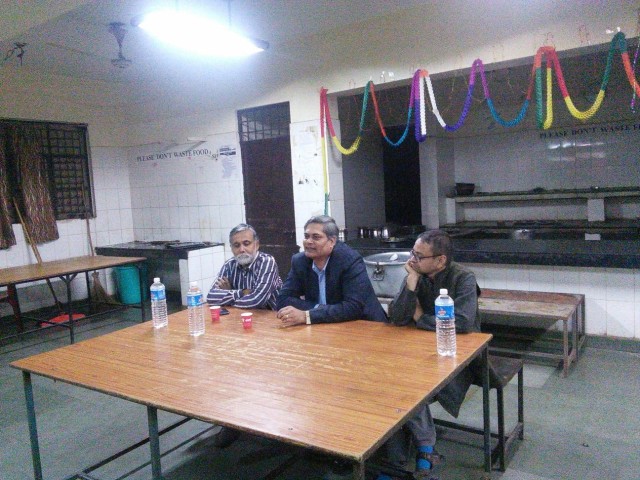23rd November 2015
In continuance of the highly acclaimed tradition of debate and discussion in the university campus, JNU Mithila Manch (JMM) organised a talk on the topic of “Growth and Development of Maithili and Mithila and its contribution to the world”. it was held at Mahi-Mandavi hostel mess in the intervening night of 20th and 21st November, 2015. The esteemed speakers were prof. Ramnath Jha, professor, special centre for sanskrit studies, JNU; Prof. Sushant Mishra, Associate professor, School of language, literature and cultural studies, JNU; Dr. Gautam Jha, Assistant professor, school of language, literature and cultural studies, JNU. The purpose of this talk was to introduce the rich intellectual, philosophical and cultural heritage of Mithila to the students of the JNU.


Initiating the discussion prof Ramnath jha, a vedic scholar, traced the lineage of the dominant traditions of our ancient philosophy including nyaya, samkhya, mimansa and all to the soil of mithila region. He categorically stated that, “the intellectual precursors of the basic traditions of famous ‘khada-darshana’ like yagnvalkya, gautam, vachaspati, mandan, pakshdar, kumaril bhatt and all were born in this pious region”. He further added that how deeply rabindranath tagore was influenced with mahakavi vidyapati which also turned into debate that to where-bengal or mithila-vidyapati belongs to. This debate, he argued, is settled now consensually that vidyapati was from mithila. While discussing contemporary influence of Maithil vedic philosophy he argued that almost all the global concerns like terrorism, environmentalism, feminism etc can be solved with the wisdom given by maithil vedic scholars. Shri Sushant Mihsra enlightened the audience with the interesting notion of existence of different cultural forms prevailing across the mithila region. he also mentioned that how subal tern discourse- which is still emerging in the world-was already flourishing in mithila region in the form of different folklores of Dina-Bhadari, Raja Salhesh, valour stories of Alha-Udal and many others. besides, he also put forth a detailed discussion on a highly advance form of feminist writing prevalent in local tradition of Madhushravani katha and many other forms of textual writings.
Dr Gautam Jha, the last speaker, added another flavour in the discussion by comparing the cultural landscape of Indonesia and mithila. He showed resemblance with many of the local folk traditions of mithila and that of the islands of Bali, Java, Sumatra and Borneo. He told that many of our grand mother or nani-maa stories have the same plot and the protagonists as their Indonesian counterparts have.
According to him, Ramayana and kathputli (puppet) dance is the most recurrent theme in both the cultural traditions. However, he expressed his concern with the declining trend of both this art forms in mithila region and India as well. The event was attended by 70-80 students who hailed from different states of India, though the majority was that of maithili speakers and sympathisers. The enthusiastic audiences kept asking relevant questions while willing speakers quenched their intellectual curiosity till midnight. Apart from this, the issue of how maithili language and culture should be promoted was also raised by concerned students. The participant students seemed contended with the responses once it was over.
The thanking note was given by Jay Chandra Akela, President, JNU Mithila Manch. He along with the speakers committed with resolve that such type of indispensable events should be organized with large scale and on regular intervals.
